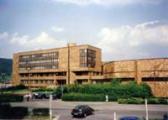Alternate names: Žilina, Zsolna, Sillein. town image. After repellling the Tatar invasion in the 13th century, King Béla IV of Hungary elevated Zilina to a royal city and invited Jews and Germans to the abandoned and depopulated town, granting them important privileges. The town later was repeatedly burned. The town archives retain no documents concerning Jewish life there in this period. Despite the *Toleranzpatent" issued by Emperor Joseph II the municipality gave no permission to Jews to settle in Zilina in the early 19th century. They were only allowed to visit markets and fairs. Nevertheless, some Jewish families were living in Zilina in 1840. An organized community formed in 1852 with 52 members and a synagogue opened in 1861, a school in 1860, and a chevra kaddisha in 1865. After Zilina became an important railway center, Jewish settlement increased with Jews taking a major role in the rapid development of business and industry. Among other enterprises were a cellulose factory and textile factories and the center of the timber trade in Slovakia. Arnold Kiss, the noted rabbi of Buda, officiated for a short while in Zilina. The Reform community rabbi David Friedmann from 1902 died in 1934 and was replaced by Hugo Stránsky, who left for London 1938. His successor, E. Lichtenstein, perished in the Holocaust. Zilina was a center of Zionist activity in Slovakia after World War I. A new synagogue, one of the most beautiful in Czechoslovakia, was built in 1934. In 1929 the Orthodox minority seceded from the community and established a separate congregation. Their last rabbi, Martin (Mordechai) Klein, a noted talmudist, returned to Zilina after the Holocaust and died soon afterward. 3,500 Jews were living there in 1940. During World War II, in 1942, the Slovak Fascist government with local collaboration established a transit concentration camp at Zilina; many thousands of Jews passed through to death camps in Poland. After the war about 700 Jewish survivors returned, out of the 3,500 living there before World War II. About 400 left for Israel or other countries before 1950; others moved to the capital or crossed the borders in 1968 after the Russian invasion of Czechoslovakia. In 1971 only a few dozen Jews, mostly of advanced age, lived in Zilina. Although the community was officially recorded as the main Jewish center for northern Slovakia, there was little congregational life. [February 2009]
US Commission No. SLCE000086
Zilina is located in Zilina, NW of Martin. The isolated flat urban location has Hebrew inscriptions on gate or wall. Reached by turning directly off a public road, access is open to all via a masonry wall and a locking gate. 500-5000 19th-20th century marble, granite, limestone, sandstone, and other materials flat shaped tombstones (some with carved relief decorations), finely smoothed and inscribed stones, double tombstones, or multi-stone monuments (some with other metallic elements or metal fences around graves) are in original locations. Inscriptions are Hebrew, German, and Slovakian. The cemetery is divided into a special section for soldiers' graves. The local Jewish community owns the property used for Jewish cemetery only. Adjacent properties are residential. Frequently, organized Jewish group tours and private individuals visit. Restoration included re-erection of stones, patching broken stones, cleaning stones, clearing vegetation, and fixing of wall. The Jewish congregation pays a regular caretaker. Within the cemetery is a pre-burial house with wall inscriptions about the holocaust. There are no threats.
January 2009:
Map of Town
Town Žilina |
|
|||
 |
Address: | Phone: |
|
|
| Mestský úrad | Fax: | 00 421 41 723 29 12 | ||
| Nám. Obetí komunizmu 1 | Email: | This email address is being protected from spambots. You need JavaScript enabled to view it. This email address is being protected from spambots. You need JavaScript enabled to view it. | ||
| 010 01 Žilina SLOVAKIA |
Web: | www.zilina.sk | ||
| Region: | Žilinský |  |
| District: | Žilina | |
| Micro region: | Horné Považie | |
| Inhabitants: | 85 477 | |
| Area: | 8 003 ha | |
| First paper reference: | in year 1208 | |
| Mayor: | Ivan Harman | |
| Chief: | Ing. Viliam Mikuláš |
